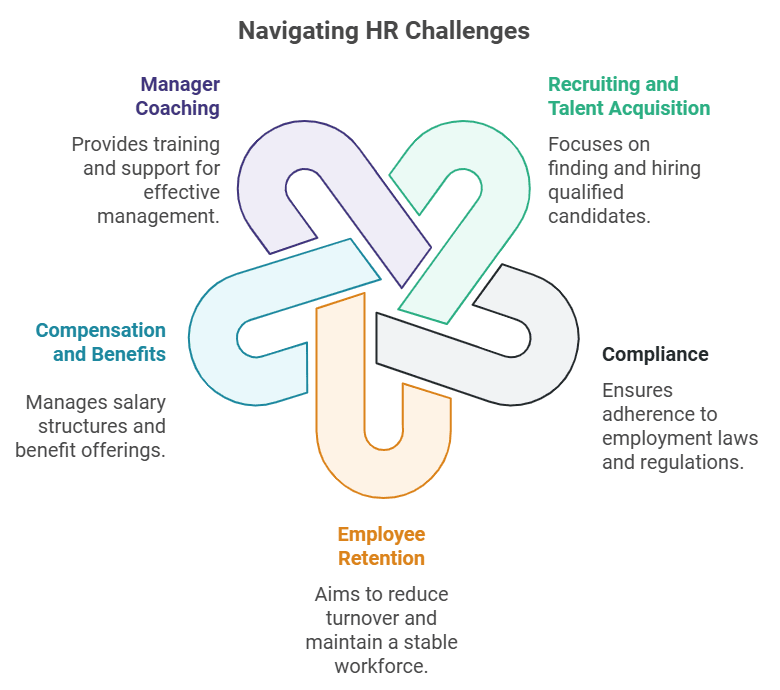-1-640x380.jpg)
Human resource management is a vast scope of work. Professionals in the space have to be well-versed in a variety of topics, from benefits to compensation management, and everything in between. There are a wide variety of specialties you can focus on as a human resource leader, such as HR generalist, employee relations coordinator, engagement and people analytics, and compliance specialty. In a large field, it can be easy to get lost and make mistakes. To avoid that, we list 5 common HR problems that you might face at your workplace and tell you what you should do that solve them.
Related articles:
How HR is Solving the Disparate Data Challenge Once and for All
Top 5 HR Challenges International Companies Face
What Is HR?
The role of a human resource manager is to own recruiting, retention, hiring, employee success, and company separation. HR professionals oversee relations within the organization, alongside basic compliance problems such as payroll, benefits, and other legalities. The human resources team at an organization is responsible for employee happiness and overall success. It is their job to understand the inner workings of a business while playing to the strengths and advantages of each and every employee. Human resources teams are typically made up of a few different focus groups. For example, you will have your standard employee relations teams, payroll administrators, Talent management (recruitment, staffing, performance management, etc.), and Learning and Development team. Each of these functions has a specific goal in mind. Typically, employee success teams are responsible for reducing turnover and ensuring that each and every employee is meeting their KPIs. The talent team is responsible for recruiting, weeding, and hiring new talent to grow organizations. The HR team is responsible for core competencies such as payroll, benefits, and other tax necessities.
Top Priorities and Responsibilities of HR Teams
First and foremost, the top priority of each and every human resource team at an organization is to ensure the health of the workforce. This means making sure that employees are fairly treated, while also making sure that the company is supporting its employees well within its means. HR teams need to ensure that the organization is compliant with state and federal laws, to ensure that the company is ready for an audit at any time. The top priorities of a human resource team include making sure. The salaries of employees are within the company budget, all laws are invited too, and the company is in good standing with the public eye.
5 Common HR Problems and How to Solve Them
Of course, HR is a human-focused profession. Therefore, there will be many twists and turns along the way. Human resources specialists must ensure that they are ready to tackle people facing challenges that come their way. This can be anything from a disgruntled employee, to an employee with benefits questions, employment law, and more. Let’s take a peek at the five most common HR problems and how we recommend that you solve them within your organization.
Recruiting and Talent Acquisition
Recruiting and talent acquisition are the main focus of every HR Team. Without the proper people to do the job, a Workforce cannot operate as intended. It is up to the talent acquisition team within the human resources function to find employees that will be a good fit for the organization as a whole. It is important to find qualified candidates to apply for the roles, while also making sure that these positions are filled with the most diverse yet qualified individuals.
The recruiting and talent acquisition team must work closely with hiring managers and existing exemplary employees, in order to grow teams sustainably. They must interview and train all of the hiring managers to make sure that they will recruit candidates that will be a good fit for the position. This can be a very time-consuming job, resulting in frustrated hiring managers. This is why an HR professional must be extremely agile and people-focused, in order to build a relationship with their hiring managers. Oftentimes, the best candidates are passive. This means that they will have to actively recruit and try to poach qualifying candidates who already have existing roles at competitor companies. This in itself takes incredible focus, alongside some basic sales skills.
The recruiting and talent acquisition team will also be responsible for communicating with the finance department and HR department, to ensure that all offers being sent out to candidates are compliant. Being out of compliance can cause a lot of HR problems for an organization. There are many factors that must be taken into consideration, such as salary offered, negotiation room, stock options, reporting structures, and other benefits that the company may provide.
It’s important to make sure that your talent acquisition team collaborates well with the core HR team. Any changes that come up within the organization, such as open enrollment, benefits offerings, perks, or organizational changes, must be communicated to potential candidates. It is important for the talent acquisition team to have updated information regarding the inner workings of a company so that they are able to sell and advertise the company as accurately as possible.
Compliance – Understanding HR Problems
Compliance is a major factor that contributes to the success of an overall organization, specifically impacting the human resource team. In order to be compliant, an organization must abide by state and federal employment laws. These laws can range from anything relating to compensation, benefits, paternity/maternity leave, equal treatment, and other core competencies that an organization must abide by. It is the responsibility of the core human resource team to ensure that the organization is up to code in case of a surprise audit. Employment regulation specialists have the authority to audit and analyze an organization at any time. So, it is important for the human resource team to always have proper documentation for all employees, and ensure current practices are up to code.
Typically, the core HR team will have an employee with significant legal experience and a background in business law or labor relations. This is to ensure that the company is constantly up-to-date on improving laws or changing procedures within the regions in which they do business.
Retention of Employees
Employee retention is a clear sign of the overall health of an organization. Oftentimes, potential employees or customers will ask for the attrition rate of a company before signing their offer letter or contract. The attrition rate shows on average, how many employees an organization has seen come and go over a period of time. Having a high attrition rate is one of the main HR problems professionals face. The turnover rate of an organization is a clear indicator of the success, happiness, and growth opportunities that each team experiences while working at the company. Management also has a big role to play in this attrition number. So, it is the responsibility of the training and development specialist on a human resource team to focus on properly training managers and providing them with the resources needed as a strategy for retaining new hires, long-term employees, and their supervisors. A low turnover rate is a signal that employees are happy working at the organization, and do not wish to seek employment elsewhere.
Compensation and Benefits
One of the biggest benefits that employees look for when joining an organization is the promise of a competitive compensation and benefits package. However, knowing what classifies as competitive is another story! It is the responsibility of the human resource team to ensure. Employees are properly leveled and paid within their skill set and experience. when making a new hire, the human resource team will assign a level to each individual. This level will indicate whether they are a beginner in their field, intermediate, or Advanced. Their experience also has something to do with their compensation overall, as those with more experience can typically expect a higher pay rate than someone fresh out of college.
Aside from salary, benefits are another key factor that plays into employee happiness, as well as the overall marketing of the company. When employees are looking for new jobs, they will often ask organizations for a one-pager on their current benefit offerings. These benefits can include perks such as unlimited PTO, provided technology, health Insurance, dental Insurance, mental health benefits, and more. Poor coverage and benefits can lead to HR problems within the organization. Ensuring that your organization is able to offer a competitive package to existing and potential employees is crucial to keeping them happy and working at the company.
Manager Coaching
As we mentioned previously, manager coaching is an essential factor that plays into the success of employees, as well as the overall prosperity of a company. In order to help employees achieve their full potential, it is important for them to have the proper coaches and mentors in place. Poorly trained managers will result in HR problems and unhappy employees. When hiring managers, it is important to have a learning and development program set up for them during onboarding. This will help them get a better grasp on how the organization likes to operate, and what managers can do to ensure the success of their employees. These success factors can include things such as weekly one-on-ones, proper feedback guides, recommendations on appropriate ways to praise oh, and much more. Growth opportunities are one of the number one reasons why candidates choose to sign job offers with specific companies! Managers can help make this goal come to fruition.

PeopleSpheres as a Solution for all HR Functions
The more your company grows, the more HR management requires multiple HR functions to work together and work as a strategic HR department. In some cases, some areas of HRM are done by outsourcing them to third parties such as a staffing agency or a third-party recruiter who does interviews on your behalf. That is why it is important that your human resources functions are consolidated in a way where you can have your people, data, and processes in one place.
PeopleSpheres connects all your HR software to a centralized platform where all your HR data can be used to create a unified experience for employees, create workflows across all information systems, and make strategic human resource management decisions based on data analysis.
We hope that this article helped you better understand some of the most common HR problems, and how to solve them within your organization. For more helpful content on excelling in the HR space, check out the rest of our blog!




-640x380.jpg)